Construction 4.0, Industry 4.0, and Building Information Modeling (BIM) for Sustainable Building Development within the Smart City
Abstract
:1. Introduction
2. Method
3. Results
3.1. Macro-Quantitative Analysis Regarding Construction 4.0, Industry 4.0, BIM, Sustainable Building, and Smart City
3.1.1. General Information
3.1.2. VOSviewer Software Analysis
- Network Visualization
- 2.
- Overlay Visualization
- (1)
- Cutting-edge concept: smart city, Industry 4.0, and Construction 4.0;
- (2)
- Building sustainable development: sustainable design, sustainable building, green building, and sustainability;
- (3)
- Factors influencing development: technologies, performance, and productivity;
- (4)
- Activity for building the life cycle: simulation, decision-making, design, implementation, management, and consumption;
- (5)
- Emerging technology and an integrated model: virtual reality, cyber-physical systems, fog, big data, augmented reality, automation, the Internet of Things, the internet, blockchain, artificial intelligence, DTs, things, BIM, CityGML, GIS, and industrial infrastructure classes.
3.2. A Follow-Up Micro-Qualitative Analysis Regarding Construction 4.0, Industry 4.0, BIM, Sustainable Building, and Smart City
3.2.1. Classification and Selection of the Influential Subject Areas
3.2.2. Research Overview of the 11 Subject Areas
- Engineering
- 2.
- Computer Science
- 3.
- Construction Building Technology
- 4.
- Science Technology and Other Topics
- 5.
- Environmental Sciences Ecology
- 6.
- Telecommunications
- 7.
- Energy Fuels
- 8.
- Business Economics
- 9.
- Chemistry
- 10.
- Automation Control Systems
- 11.
- Materials Science
3.2.3. Micro-Qualitative Analysis of Life-Cycle Stages
4. Discussion
4.1. Current and Future Trends
4.2. The Development and Challenges of Multidisciplinary and Building Life Cycle Research
5. Conclusions
Author Contributions
Funding
Institutional Review Board Statement
Informed Consent Statement
Data Availability Statement
Conflicts of Interest
References
- Silva, B.N.; Khan, M.; Han, K. Towards Sustainable Smart Cities: A Review of Trends, Architectures, Components, and Open Challenges in Smart Cities. Sustain. Cities Soc. 2018, 38, 697–713. [Google Scholar] [CrossRef]
- Graham, S.; Marvin, S. Telecommunications and the City: Electronic Spaces, Urban Places, 1st ed.; Routledge: London, UK, 1995. [Google Scholar]
- Neirotti, P.; De Marco, A.; Cagliano, A.C.; Mangano, G.; Scorrano, F. Current Trends in Smart City Initiatives: Some Stylised Facts. Cities 2014, 38, 25–36. [Google Scholar] [CrossRef]
- Ramaprasad, A.; Sánchez-Ortiz, A.; Syn, T. A Unified Definition of a Smart City. In Proceedings of the International Conference on Electronic Government, Petersburg, Russia, 4–7 September 2017. [Google Scholar]
- Dameri, R. Searching for Smart City Definition: A Comprehensive Proposal. Int. J. Comput. Technol. 2013, 11, 2544–2551. [Google Scholar] [CrossRef]
- Ejaz, W.; Naeem, M.; Shahid, A.; Anpalagan, A.; Jo, M. Efficient Energy Management for the Internet of Things in Smart Cities. IEEE Commun. Mag. 2017, 55, 84–91. [Google Scholar] [CrossRef]
- Mohanty, S.P.; Choppali, U.; Kougianos, E. Everything You Wanted to Know about Smart Cities: The Internet of Things Is the Backbone. IEEE Consum. Electron. Mag. 2016, 5, 60–70. [Google Scholar] [CrossRef]
- Yigitcanlar, T.; Kamruzzaman, M.; Foth, M.; Sabatini-Marques, J.; da Costa, E.; Ioppolo, G. Can Cities Become Smart without Being Sustainable? A Systematic Review of the Literature. Sustain. Cities Soc. 2019, 45, 348–365. [Google Scholar] [CrossRef]
- Bock, T. The Future of Construction Automation: Technological Disruption and the Upcoming Ubiquity of Robotics. Autom. Constr. 2015, 59, 113–121. [Google Scholar] [CrossRef]
- Karmakar, A.; Delhi, V.S.K. Construction 4.0: What We Know and Where We Are Headed? J. Inf. Technol. Constr. ITcon 2021, 26, 526–545. [Google Scholar] [CrossRef]
- Boyes, H.; Hallaq, B.; Cunningham, J.; Watson, T. The Industrial Internet of Things (IIoT): An Analysis Framework. Comput. Ind. 2018, 101, 1–12. [Google Scholar] [CrossRef]
- Roblek, V.; Meško, M.; Krapež, A. A Complex View of Industry 4.0. SAGE Open 2016, 6, 1–11. [Google Scholar] [CrossRef]
- Lasi, H.; Fettke, P.; Kemper, H.-G.; Feld, T.; Hoffmann, M. Industry 4.0. Bus. Inf. Syst. Eng. 2014, 6, 239–242. [Google Scholar] [CrossRef]
- Forcael, E.; Ferrari, I.; Opazo-Vega, A.; Pulido-Arcas, J.A. Construction 4.0: A Literature Review. Sustainability 2020, 12, 9755. [Google Scholar] [CrossRef]
- Schober, K.S.; Hoff, P. Digitization in the Construction Industry: Building Europe’s Road to ‘Construction 4.0’. In Think Act; Roland Berger GMBH: Munich, Germany, 2016; pp. 1–16. [Google Scholar]
- Sacks, R.; Brilakis, I.; Pikas, E.; Xie, H.S.; Girolami, M. Construction with Digital Twin Information Systems. Data-Centric Eng. 2020, 1, e14. [Google Scholar] [CrossRef]
- Osunsanmi, O.; Aigbavboa, C.; Oke, A.; Ohiomah, I. Construction 4.0: Towards Delivering of Sustainable Houses in South Africa. In Proceedings of the Creative Construction Conference 2018, Ljubljana, Slovenia, 30 June–3 July 2018. [Google Scholar]
- Sawhney, A.; Riley, M.; Irizarry, J.; Pérez, C.T. A Proposed Framework for Construction 4.0 Based on a Review of Literature. EPiC Ser. Built Environ. 2020, 1, 301–309. [Google Scholar]
- Hossan, M.; Nadeem, A. Towards Digitizing the Construction Industry: State of the Art of Construction 4.0. In Proceedings of the 10th International Structural Engineering and Construction, Chicago, IL, USA, 1 May 2019. [Google Scholar]
- Panteli, C.; Kylili, A.; Fokaides, P.A. Building Information Modelling Applications in Smart Buildings: From Design to Commissioning and beyond A Critical Review. J. Clean. Prod. 2020, 265, 121766. [Google Scholar] [CrossRef]
- Liu, S. Sustainable Building Design Optimization Using Building Information Modeling. In Proceedings of the International Conference on Construction and Real Estate Management, Luleå, Sweden, 11–12 August 2015; pp. 326–335. [Google Scholar]
- Crippa, J.; Araujo, A.M.F.; Bem, D.; Ugaya, C.M.L.; Scheer, S. A Systematic Review of BIM Usage for Life Cycle Impact Assessment. Built Environ. Proj. Asset Manag. 2020, 10, 603–618. [Google Scholar] [CrossRef]
- Kylili, A.; Fokaides, P.A. Policy Trends for the Sustainability Assessment of Construction Materials: A Review. Sustain. Cities Soc. 2017, 35, 280–288. [Google Scholar] [CrossRef]
- Panteli, C.; Polycarpou, K.; Morsink-Georgalli, F.Z.; Stasiuliene, L.; Pupeikis, D.; Jurelionis, A.; Fokaides, P.A. Overview of BIM Integration into the Construction Sector in European Member States and European Union Acquis. IOP Conf. Ser. Earth Environ. Sci. 2020, 410, 012073. [Google Scholar] [CrossRef]
- Ayman, R.; Alwan, Z.; McIntyre, L. BIM for Sustainable Project Delivery: Review Paper and Future Development Areas. Archit. Sci. Rev. 2020, 63, 15–33. [Google Scholar] [CrossRef]
- Ding, Z.; Zheng, K.; Tan, Y. BIM Research vs. BIM Practice: A Bibliometric-Qualitative Analysis from China. Eng. Constr. Archit. Manag. 2021. [Google Scholar] [CrossRef]
- Khudhair, A.; Li, H.; Ren, G.; Liu, S. Towards Future BIM Technology Innovations: A Bibliometric Analysis of the Literature. Appl. Sci. 2021, 11, 1232. [Google Scholar] [CrossRef]
- Liu, H.; Skibniewski, M.J.; Ju, Q.; Li, J.; Jiang, H. BIM-Enabled Construction Innovation through Collaboration: A Mixed-Methods Systematic Review. Eng. Constr. Archit. Manag. 2021, 28, 1541–1560. [Google Scholar] [CrossRef]
- Olawumi, T.O.; Chan, D.W.M.; Wong, J.K.W. Evolution in the Intellectual Structure of BIM Research: A Bibliometric Analysis. J. Civ. Eng. Manag. 2017, 23, 1060–1081. [Google Scholar] [CrossRef]
- Zhong, L.; Zhang, L.; Li, Y.; Liang, X.; Kong, L.; Shen, X.; Wu, T. Assessment of the Toxicity of Quantum Dots through Biliometric Analysis. Int. J. Environ. Res. Public. Health 2021, 18, 5768. [Google Scholar] [CrossRef] [PubMed]
- Dias, G.P. Smart Cities Research in Portugal and Spain: An Exploratory Biliometric Analysis. In Proceedings of the 2018 13th Iberian Conference on Information Systems and Technologies (CISTI), Caceres, Spain, 13–16 June 2018. [Google Scholar]
- Kozlovska, M.; Klosova, D.; Strukova, Z. Impact of Industry 4.0 Platform on the Formation of Construction 4.0 Concept: A Literature Review. Sustainability 2021, 13, 2683. [Google Scholar] [CrossRef]
- Shkundalov, D.; Vilutienė, T. Bibliometric Analysis of Building Information Modeling, Geographic Information Systems and Web Environment Integration. Autom. Constr. 2021, 128, 103757. [Google Scholar] [CrossRef]
- Wang, X.; Fang, Z.; Sun, X. Usage Patterns of Scholarly Articles on Web of Science: A Study on Web of Science Usage Count. Scientometrics 2016, 109, 917–926. [Google Scholar] [CrossRef]
- Powell, K.R.; Peterson, S.R. Coverage and Quality: A Comparison of Web of Science and Scopus Databases for Reporting Faculty Nursing Publication Metrics. Nurs. Outlook 2017, 65, 572–578. [Google Scholar] [CrossRef] [PubMed]
- Hosseini, M.R.; Martek, I.; Zavadskas, E.K.; Aibinu, A.A.; Arashpour, M.; Chileshe, N. Critical Evaluation of Off-Site Construction Research: A Scientometric Analysis. Autom. Constr. 2018, 87, 235–247. [Google Scholar] [CrossRef]
- Van Eck, N.J.; Waltman, L. VOS: A New Method for Visualizing Similarities Between Objects. In Proceedings of the 30th Annual Conference of the German-Classification-Society, Berlin, Germany, 08–10 March 2006. [Google Scholar]
- Shahrour, I.; Alileche, L.; Alfurjani, A. Smart Cities: System and Tools Used for the Digital Modelling of Physical Urban Systems. In Proceedings of the 2017 Sensors Networks Smart and Emerging Technologies (SENSET), Beiriut, Lebanon, 12–14 September 2017. [Google Scholar]
- Tao, Y.X.; Zhu, Y.; Passe, U. Modeling and Data Infrastructure for Human-Centric Design and Operation of Sustainable, Healthy Buildings through a Case Study. Build. Environ. 2020, 170, 106518. [Google Scholar] [CrossRef]
- Fargnoli, M.; Lombardi, M. Building Information Modelling (BIM) to Enhance Occupational Safety in Construction Activities: Research Trends Emerging from One Decade of Studies. Buildings 2020, 10, 98. [Google Scholar] [CrossRef]
- Baldanzi, L.; Crocetti, L.; Di Matteo, S.; Fanucci, L.; Saponara, S.; Hameau, P. Crypto Accelerators for Power-Efficient and Real-Time on-Chip Implementation of Secure Algorithms. In Proceedings of the 2019 26th IEEE International Conference on Electronics, Circuits and Systems (ICECS), Genoa, Italy, 27–29 November 2019. [Google Scholar]
- Yevu, S.K.; Yu, A.T.W.; Darko, A. Digitalization of Construction Supply Chain and Procurement in the Built Environment: Emerging Technologies and Opportunities for Sustainable Processes. J. Clean. Prod. 2021, 322, 129093. [Google Scholar] [CrossRef]
- Sun, X. Semantic 3D Building Model Construction for Smart Urban Management. In Proceedings of the 2015 International Conference on Industrial Technology and Management Science (ITMS 2015), Tianjin, China, 27–28 March 2015. [Google Scholar]
- Xue, F.; Wu, L.; Lu, W. Semantic Enrichment of Building and City Information Models: A Ten-Year Review. Adv. Eng. Inform. 2021, 47, 101245. [Google Scholar] [CrossRef]
- Xue, F.; Lu, W.; Chen, K.; Webster, C.J. BIM Reconstruction from 3D Point Clouds: A Semantic Registration Approach Based on Multimodal Optimization and Architectural Design Knowledge. Adv. Eng. Inform. 2019, 42, 100965. [Google Scholar] [CrossRef]
- Xue, F.; Lu, W.; Chen, K.; Zetkulic, A. From Semantic Segmentation to Semantic Registration: Derivative-Free Optimization–Based Approach for Automatic Generation of Semantically Rich As-Built Building Information Models from 3D Point Clouds. J. Comput. Civ. Eng. 2019, 33, 04019024. [Google Scholar] [CrossRef]
- Milanov, Y.; Badenko, V.; Yadykin, V.; Perlovsky, L. Method for Clustering and Identification of Objects in Laser Scanning Point Clouds Using Dynamic Logic. Int. J. Adv. Manuf. Technol. 2021, 117, 2309–2318. [Google Scholar] [CrossRef]
- Petrova, E.; Pauwels, P.; Svidt, K.; Jensen, R.L. Towards Data-Driven Sustainable Design: Decision Support Based on Knowledge Discovery in Disparate Building Data. Archit. Eng. Des. Manag. 2019, 15, 334–356. [Google Scholar] [CrossRef]
- Wagire, A.A.; Rathore, A.P.S.; Jain, R. Exploration of Pillars of Industry 4.0 Using Latent Semantic Analysis Technique. Intell. Manuf. Energy Sustain. 2020, 169, 711–719. [Google Scholar]
- Humayun, M.; Jhanjhi, N.; Alruwaili, M.; Amalathas, S.S.; Balasubramanian, V.; Selvaraj, B. Privacy Protection and Energy Optimization for 5G-Aided Industrial Internet of Things. IEEE Access 2020, 8, 183665–183677. [Google Scholar] [CrossRef]
- Leccisi, M.; Leccese, F.; Moretti, F.; Blaso, L.; Brutti, A.; Gozo, N. An IoT Application for Industry 4.0: A New and Efficient Public Lighting Management Model. In Proceedings of the 2020 IEEE International Workshop on Metrology for Industry 4.0 & IoT, Roma, Italy, 3–5 June 2020. [Google Scholar]
- Mylonas, G.; Kalogeras, A.; Kalogeras, G.; Anagnostopoulos, C.; Alexakos, C.; Muñoz, L. Digital Twins from Smart Manufacturing to Smart Cities: A Survey. IEEE Access 2021, 9, 143222–143249. [Google Scholar] [CrossRef]
- Ozturk, G.B. Digital Twin Research in the AECO-FM Industry. J. Build. Eng. 2021, 40, 102730. [Google Scholar] [CrossRef]
- Ning, H.; Wang, H.; Lin, Y.; Wang, W.; Dhelim, S.; Farha, F.; Ding, J.; Daneshmand, M. A Survey on Metaverse: The State-of-the-Art, Technologies, Applications, and Challenges. arXiv 2021, arXiv:2111.09673. [Google Scholar]
- Darko, A.; Chan, A.P.C.; Adabre, M.A.; Edwards, D.J.; Hosseini, M.R.; Ameyaw, E.E. Artificial Intelligence in the AEC Industry: Scientometric Analysis and Visualization of Research Activities. Autom. Constr. 2020, 112, 103081. [Google Scholar] [CrossRef]
- Maureira, C.; Pinto, H.; Yepes, V.; García, J. Towards an AEC-AI Industry Optimization Algorithmic Knowledge Mapping: An Adaptive Methodology for Macroscopic Conceptual Analysis. IEEE Access 2021, 9, 110842–110879. [Google Scholar] [CrossRef]
- Martynov, V.V.; Shavaleeva, D.N.; Zaytseva, A.A. Information Technology as the Basis for Transformation into a Digital Society and Industry 5.0. In Proceedings of the 2019 International Conference “Quality Management, Transport and Information Security, Information Technologies” (IT&QM&IS), Sochi, Russia, 23–27 September 2019. [Google Scholar]
- Haruna, A.; Shafiq, N.; Montasir, O.A. Building Information Modelling Application for Developing Sustainable Building (Multi Criteria Decision Making Approach). Ain Shams Eng. J. 2021, 12, 293–302. [Google Scholar] [CrossRef]
- Inyim, P.; Rivera, J.; Zhu, Y. Integration of Building Information Modeling and Economic and Environmental Impact Analysis to Support Sustainable Building Design. J. Manag. Eng. 2015, 31, A4014002. [Google Scholar] [CrossRef]
- Liu, Z.; Jiang, L.; Osmani, M.; Demian, P. Building Information Management (BIM) and Blockchain (BC) for Sustainable Building Design Information Management Framework. Electronics 2019, 8, 724. [Google Scholar] [CrossRef]
- Najjar, M.; Figueiredo, K.; Palumbo, M.; Haddad, A. Integration of BIM and LCA: Evaluating the Environmental Impacts of Building Materials at an Early Stage of Designing a Typical Office Building. J. Build. Eng. 2017, 14, 115–126. [Google Scholar] [CrossRef]
- Najjar, M.; Figueiredo, K.; Hammad, A.W.A.; Haddad, A. Integrated Optimization with Building Information Modeling and Life Cycle Assessment for Generating Energy Efficient Buildings. Appl. Energy 2019, 250, 1366–1382. [Google Scholar] [CrossRef]
- Gavali, H.R.; Ralegaonkar, R.V. Application of Information Modelling for Sustainable Urban-Poor Housing in India. Proc. Inst. Civ. Eng.—Eng. Sustain. 2019, 172, 68–75. [Google Scholar] [CrossRef]
- Kurian, C.P.; Milhoutra, S.; George, V.I. Sustainable Building Design Based on Building Information Modeling (BIM). In Proceedings of the 2016 IEEE International Conference on Power System Technology (POWERCON), Wollongong, NSW, Australia, 28 September–1 October 2016. [Google Scholar]
- Liu, Z.; Zhang, C.; Guo, Y.; Osmani, M.; Demian, P. A Building Information Modelling (BIM) Based Water Efficiency (BWe) Framework for Sustainable Building Design and Construction Management. Electronics 2019, 8, 599. [Google Scholar] [CrossRef]
- Safiullin, A.; Krasnyuk, L.; Kapelyuk, Z. Integration of Industry 4.0 Technologies for “Smart Cities” Development. IOP Conf. Ser. Mater. Sci. Eng. 2019, 497, 012089. [Google Scholar] [CrossRef]
- Boton, C.; Rivest, L.; Ghnaya, O.; Chouchen, M. What Is at the Root of Construction 4.0: A Systematic Review of the Recent Research Effort. Arch. Comput. Methods Eng. 2021, 28, 2331–2350. [Google Scholar] [CrossRef]
- Scheffer, M.; Konig, M.; Engelmann, T.; Tagliabue, L.C.; Ciribini, A.L.C.; Rinaldi, S.; Pasetti, M. Evaluation of Open Data Models for the Exchange of Sensor Data in Cognitive Building. In Proceedings of the 2018 Workshop on Metrology for Industry 4.0 and IoT, Brescia, Italy, 16–18 April 2018. [Google Scholar]
- Nesi, P.; Pantaleo, G.; Paolucci, M.; Zaza, I. Auditing and Assessment of Data Traffic Flows in an IoT Architecture. In Proceedings of the 2018 IEEE 4th International Conference on Collaboration and Internet Computing (CIC), Philadelphia, PA, USA, 18–20 October 2018. [Google Scholar]
- Noje, D.; Dzitac, I.; Pop, N.; Tarca, R. IoT Devices Signals Processing Based on Shepard Local Approximation Operators Defined in Riesz MV-Algebras. Informatica 2020, 31, 131–142. [Google Scholar] [CrossRef]
- Oztemel, E.; Gursev, S. Literature Review of Industry 4.0 and Related Technologies. J. Intell. Manuf. 2020, 31, 127–182. [Google Scholar] [CrossRef]
- López Martínez, P.; Dintén, R.; Drake, J.M.; Zorrilla, M. A Big Data-Centric Architecture Metamodel for Industry 4.0. Future Gener. Comput. Syst. 2021, 125, 263–284. [Google Scholar] [CrossRef]
- Ren, S.; Kim, J.-S.; Cho, W.-S.; Soeng, S.; Kong, S.; Lee, K.-H. Big Data Platform for Intelligence Industrial IoT Sensor Monitoring System Based on Edge Computing and AI. In Proceedings of the 2021 International Conference on Artificial Intelligence in Information and Communication (ICAIIC), Jeju Island, Korea, 13–16 April 2021. [Google Scholar]
- Augustine, P. The Industry Use Cases for the Digital Twin Idea. In Advances in Computers; Elsevier: Amsterdam, The Netherlands, 2020; Volume 117, pp. 79–105. [Google Scholar]
- Postránecký, M.; Svítek, M. Smart City near to 4.0—An Adoption of Industry 4.0 Conceptual Model. In Proceedings of the 2017 Smart City Symposium Prague (SCSP), Prague, Czech Republic, 25–26 May 2017. [Google Scholar]
- Akın, Ş.; Ergün, O.; Surer, E.; Dino, İ.G. An Immersive Design Environment for Performance-Based Architectural Design: A BIM-Based Approach. In Proceedings of the 4th EAI International Conference on Smart Objects and Technologies for Social Good, Bologna, Italy, 28–30 November 2018. [Google Scholar]
- Predescu, A.; Mocanu, M.; Lupu, C. ARMAX: A Mobile Geospatial Augmented Reality Platform for Serious Gaming. In Proceedings of the 2019 IEEE 15th International Conference on Intelligent Computer Communication and Processing (ICCP), Cluj-Napoca, Romania, 5–7 September 2019. [Google Scholar]
- Mystakidis, S. Metaverse. Encyclopedia 2022, 2, 486–497. [Google Scholar] [CrossRef]
- Chen, Q.; Chen, J.; Huang, W. Visualizing Large-Scale Building Information Modeling Models within Indoor and Outdoor Environments Using a Semantics-Based Method. ISPRS Int. J. Geo-Inf. 2021, 10, 756. [Google Scholar] [CrossRef]
- Lee, J.; Kim, J. BIM-Based 4D Simulation to Improve Module Manufacturing Productivity for Sustainable Building Projects. Sustainability 2017, 9, 426. [Google Scholar] [CrossRef]
- Olawumi, T.O.; Chan, D.W.M. Identifying and Prioritizing the Benefits of Integrating BIM and Sustainability Practices in Construction Projects: A Delphi Survey of International Experts. Sustain. Cities Soc. 2018, 40, 16–27. [Google Scholar] [CrossRef]
- Ebertshäuser, S.; Graf, K.; Both, P.V.; Rexroth, K.; Bari, R.D.; Horn, R. Sustainable Building Information Modeling in the Context of Model-Based Integral Planning. IOP Conf. Ser. Earth Environ. Sci. 2019, 323, 012113. [Google Scholar] [CrossRef]
- Manzoor, B.; Othman, I.; Gardezi, S.S.S.; Harirchian, E. Strategies for Adopting Building Information Modeling (BIM) in Sustainable Building Projects—A Case of Malaysia. Buildings 2021, 11, 249. [Google Scholar] [CrossRef]
- Azzi, M.; Duc, H.; Ha, Q.P. Toward Sustainable Energy Usage in the Power Generation and Construction Sectors—A Case Study of Australia. Autom. Constr. 2015, 59, 122–127. [Google Scholar] [CrossRef]
- Chelyshkov, P. Computer-Aided Design of Cyber-Physical Building Systems. E3S Web Conf. 2019, 97, 01012. [Google Scholar] [CrossRef]
- Yamamura, S.; Fan, L.; Suzuki, Y. Assessment of Urban Energy Performance through Integration of BIM and GIS for Smart City Planning. Procedia Eng. 2017, 180, 1462–1472. [Google Scholar] [CrossRef]
- Harter, H.; Singh, M.M.; Schneider-Marin, P.; Lang, W.; Geyer, P. Uncertainty Analysis of Life Cycle Energy Assessment in Early Stages of Design. Energy Build. 2020, 208, 109635. [Google Scholar] [CrossRef]
- Qi, B.; Razkenari, M.; Costin, A.; Kibert, C.; Fu, M. A Systematic Review of Emerging Technologies in Industrialized Construction. J. Build. Eng. 2021, 39, 102265. [Google Scholar] [CrossRef]
- Zhang, J.; Zhao, L.; Ren, G.; Li, H.; Li, X. Special Issue “Digital Twin Technology in the AEC Industry”. Adv. Civ. Eng. 2020, 2020, e8842113. [Google Scholar] [CrossRef]
- Chen, C.; Tang, L. BIM-Based Integrated Management Workflow Design for Schedule and Cost Planning of Building Fabric Maintenance. Autom. Constr. 2019, 107, 102944. [Google Scholar] [CrossRef]
- Kamari, A.; Schultz, C.P.L.; Kirkegaard, P.H. Constraint-Based Renovation Design Support through the Renovation Domain Model. Autom. Constr. 2019, 104, 265–280. [Google Scholar] [CrossRef]
- Olawumi, T.O.; Chan, D.W.M. Critical Success Factors for Implementing Building Information Modeling and Sustainability Practices in Construction Projects: A Delphi Survey. Sustain. Dev. 2019, 27, 587–602. [Google Scholar] [CrossRef]
- Lee, J.Y.; Irisboev, I.O.; Ryu, Y.-S. Literature Review on Digitalization in Facilities Management and Facilities Management Performance Measurement: Contribution of Industry 4.0 in the Global Era. Sustainability 2021, 13, 13432. [Google Scholar] [CrossRef]
- Marzouk, M.; Othman, A. Planning Utility Infrastructure Requirements for Smart Cities Using the Integration between BIM and GIS. Sustain. Cities Soc. 2020, 57, 102120. [Google Scholar] [CrossRef]
- Reisinger, J.; Hollinsky, P.; Kovacic, I. Design Guideline for Flexible Industrial Buildings Integrating Industry 4.0 Parameters. Sustainability 2021, 13, 10627. [Google Scholar] [CrossRef]
- Kuguoglu, B.K.; van der Voort, H.; Janssen, M. The Giant Leap for Smart Cities: Scaling Up Smart City Artificial Intelligence of Things (AIoT) Initiatives. Sustainability 2021, 13, 12295. [Google Scholar] [CrossRef]
- Wang, H. Sensing Information Modelling for Smart City. In Proceedings of the 2015 IEEE International Conference on Smart City/SocialCom/SustainCom (SmartCity), Chengdu, China, 19–21 December 2015. [Google Scholar]
- Xue, K.; Hossain, M.U.; Liu, M.; Ma, M.; Zhang, Y.; Hu, M.; Chen, X.; Cao, G. BIM Integrated LCA for Promoting Circular Economy towards Sustainable Construction: An Analytical Review. Sustainability 2021, 13, 1310. [Google Scholar] [CrossRef]
- GhaffarianHoseini, A.; Zhang, T.; Nwadigo, O.; GhaffarianHoseini, A.; Naismith, N.; Tookey, J.; Raahemifar, K. Application of ND BIM Integrated Knowledge-Based Building Management System (BIM-IKBMS) for Inspecting Post-Construction Energy Efficiency. Renew. Sustain. Energy Rev. 2017, 72, 935–949. [Google Scholar] [CrossRef]
- Seghier, T.E.; Ahmad, M.H.; Wah, L.Y.; Samuel, W.O. Integration Models of Building Information Modelling and Green Building Rating Systems: A Review. Adv. Sci. Lett. 2018, 24, 4121–4125. [Google Scholar] [CrossRef]
- Veselka, J.; Nehasilová, M.; Dvořáková, K.; Ryklová, P.; Volf, M.; Růžička, J.; Lupíšek, A. Recommendations for Developing a BIM for the Purpose of LCA in Green Building Certifications. Sustainability 2020, 12, 6151. [Google Scholar] [CrossRef]
- Pai, V.; Elzarka, H. Whole Building Life Cycle Assessment for Buildings: A Case Study ON HOW to Achieve the LEED Credit. J. Clean. Prod. 2021, 297, 126501. [Google Scholar] [CrossRef]
- Marzouk, M.; Azab, S.; Metawie, M. Framework for Sustainable Low-Income Housing Projects Using Building Information Modeling. J. Environ. Inform. 2016, 28, 25–38. [Google Scholar] [CrossRef]
- Liu, K.S.; Shih, Y.L.; Tzeng, C.T.; Chen, C.C. Research on Energy-saving Design Transformation on the External Shell of Existing Buildings—The Example of Kaohsiung City Townhouses. J. Environ. Prot. Ecol. JEPE 2014, 15, 1303–1314. [Google Scholar]
- Widyatmoko, I. Digital Transformation to Improve Quality, Efficiency and Safety in Construction of Roads Incorporating Recycled Materials. IOP Conf. Ser. Earth Environ. Sci. 2020, 599, 012093. [Google Scholar] [CrossRef]
- Khalesi, H.; Balali, A.; Valipour, A.; Antucheviciene, J.; Migilinskas, D.; Zigmund, V. Application of Hybrid SWARA–BIM in Reducing Reworks of Building Construction Projects from the Perspective of Time. Sustainability 2020, 12, 8927. [Google Scholar] [CrossRef]
- Montiel-Santiago, F.J.; Hermoso-Orzáez, M.J.; Terrados-Cepeda, J. Sustainability and Energy Efficiency: BIM 6D. Study of the BIM Methodology Applied to Hospital Buildings. Value of Interior Lighting and Daylight in Energy Simulation. Sustainability 2020, 12, 5731. [Google Scholar] [CrossRef]
- Amoruso, F.M.; Dietrich, U.; Schuetze, T. Indoor Thermal Comfort Improvement through the Integrated BIM-Parametric Workflow-Based Sustainable Renovation of an Exemplary Apartment in Seoul, Korea. Sustainability 2019, 11, 3950. [Google Scholar] [CrossRef]
- Hetemi, E.; Ordieres-Meré, J.; Nuur, C. An Institutional Approach to Digitalization in Sustainability-Oriented Infrastructure Projects: The Limits of the Building Information Model. Sustainability 2020, 12, 3893. [Google Scholar] [CrossRef]
- Saragih, L.R.; Dachyar, M.; Zagloel, T.Y.M.; Satar, M. The Industrial IoT for Nusantara. In Proceedings of the 2018 IEEE International Conference on Internet of Things and Intelligence System (IOTAIS), Bali, Indonesia, 1–3 November 2018. [Google Scholar]
- Dahmane, W.M.; Ouchani, S.; Bouarfa, H. Towards a Reliable Smart City through Formal Verification and Network Analysis. Comput. Commun. 2021, 180, 171–187. [Google Scholar] [CrossRef]
- Liu, Z.; Yang, Z.; Osmani, M. The Relationship between Sustainable Built Environment, Art Therapy and Therapeutic Design in Promoting Health and Well-Being. Int. J. Environ. Res. Public. Health 2021, 18, 10906. [Google Scholar] [CrossRef]
- Verma, R. Smart City Healthcare Cyber Physical System: Characteristics, Technologies and Challenges. Wirel. Pers. Commun. 2022, 122, 1413–1433. [Google Scholar] [CrossRef]
- Abbas, K.; Tawalbeh, L.A.; Rafiq, A.; Muthanna, A.; Elgendy, I.A.; Abd El-Latif, A.A. Convergence of Blockchain and IoT for Secure Transportation Systems in Smart Cities. Secur. Commun. Netw. 2021, 2021, e5597679. [Google Scholar] [CrossRef]
- Benhamida, F.Z.; Casado-Mansilla, D.; Bennani, C.; López-de-Ipiña, D. Toward a Delay Tolerant Internet of Things. In Proceedings of the 9th International Conference on the Internet of Things, Bilbao, Spain, 22–25 October 2019. [Google Scholar]
- Abdelhameed, W. Sustainable Design Approach: A Case Study of BIM Use. E3S Web Conf. 2017, 23, 2001. [Google Scholar] [CrossRef]
- Pučko, Z.; Maučec, D.; Šuman, N. Energy and Cost Analysis of Building Envelope Components Using BIM: A Systematic Approach. Energies 2020, 13, 2643. [Google Scholar] [CrossRef]
- Zubov, D.; Siniak, N.; Grencikova, A. Impact of Industry 4.0 Technologies on the Employment of the People with Eye Problems: A Case Study on the Spatial Cognition Within Industrial Facilities. In Proceedings of the International Scientific Conference on The Impact of Industry 4.0 on Job Creation, Trencianske Teplice, Slovakia, 22 November 2018. [Google Scholar]
- Maskuriy, R.; Selamat, A.; Ali, K.N.; Mahdzir, A.; Marešová, P.; Krejcar, O. University Spin-Off: Effective Solution on Technology Transfer in AEC Industry for Intelligent City Transformation. In Proceedings of the 19th International Scientific Conference on Hradec Economic Days, Hradec Kralove, Czech Republic, 25–26 March 2021. [Google Scholar]
- Chen, Z.; Liu, P.; Yang, Y. Optimizing Sustainable Building’s Performance through Integrated Building Information Modeling Technology. In Proceedings of the 7th International Conference on Education, Management, Information and Mechanical Engineering (EMIM 2017), Shenyang, China, 28–30 April 2017. [Google Scholar]
- Bolshakov, N.; Badenko, V.; Yadykin, V.; Celani, A. As-Built BIM in Real Estate Management: The Change of Paradigm in Digital Transformation of Economy. IOP Conf. Ser. Mater. Sci. Eng. 2020, 940, 012017. [Google Scholar] [CrossRef]
- Balasubramanian, S.; Shukla, V.; Islam, N.; Manghat, S. Construction Industry 4.0 and Sustainability: An Enabling Framework. IEEE Trans. Eng. Manag. 2021, 1–19. [Google Scholar] [CrossRef]
- Ziolkowski, A. Modelling of Digital Transformation Processes in Organizations. In Proceedings of the 35th International-Business-Information-Management-Association Conference (IBIMA), Seville, Spain, 1–2 April 2020. [Google Scholar]
- Demirkesen, S.; Tezel, A. Investigating Major Challenges for Industry 4.0 Adoption among Construction Companies. Eng. Constr. Archit. Manag. 2021, 29, 1470–1503. [Google Scholar] [CrossRef]
- Mannino, A.; Dejaco, M.C.; Re Cecconi, F. Building Information Modelling and Internet of Things Integration for Facility Management—Literature Review and Future Needs. Appl. Sci. 2021, 11, 3062. [Google Scholar] [CrossRef]
- Slaný, V.; Lučanský, A.; Koudelka, P.; Mareček, J.; Krčálová, E.; Martínek, R. An Integrated IoT Architecture for Smart Metering Using Next Generation Sensor for Water Management Based on LoRaWAN Technology: A Pilot Study. Sensors 2020, 20, 4712. [Google Scholar] [CrossRef]
- Poza-Lujan, J.-L.; Posadas-Yagüe, J.-L.; Simó-Ten, J.-E.; Blanes, F. Distributed Architecture to Integrate Sensor Information: Object Recognition for Smart Cities. Sensors 2020, 20, 112. [Google Scholar] [CrossRef] [PubMed]
- Turner, C.J.; Oyekan, J.; Stergioulas, L.; Griffin, D. Utilizing Industry 4.0 on the Construction Site: Challenges and Opportunities. IEEE Trans. Ind. Inform. 2021, 17, 746–756. [Google Scholar] [CrossRef]
- Sorokač, A.; Rigali, L. Industry 4.0 and Smart City in Mobile Machine’s Control Systems. IFAC-PapersOnLine 2019, 52, 473–476. [Google Scholar] [CrossRef]
- Ding, K.; Shi, H.; Hui, J.; Liu, Y.; Zhu, B.; Zhang, F.; Cao, W. Smart Steel Bridge Construction Enabled by BIM and Internet of Things in Industry 4.0: A Framework. In Proceedings of the 2018 IEEE 15th International Conference on Networking, Sensing and Control (ICNSC), Zhuhai, China, 27–29 March 2018. [Google Scholar]
- Schimanski, C.P.; Pasetti Monizza, G.; Marcher, C.; Matt, D.T. Pushing Digital Automation of Configure-to-Order Services in Small and Medium Enterprises of the Construction Equipment Industry: A Design Science Research Approach. Appl. Sci. 2019, 9, 3780. [Google Scholar] [CrossRef]
- Maskuriy, R.; Selamat, A.; Ali, K.N.; Maresova, P.; Krejcar, O. Industry 4.0 for the Construction Industry—How Ready Is the Industry? Appl. Sci. 2019, 9, 2819. [Google Scholar] [CrossRef]
- Liu, K.S.; Chen, C.C. The Effects of Deep Balcony of Different Building Heights on Indoor Lighting and Thermo-Environment. Appl. Ecol. Environ. Res. 2017, 15, 103–109. [Google Scholar] [CrossRef]
- Li, Y.-W.; Cao, K. Establishment and Application of Intelligent City Building Information Model Based on BP Neural Network Model. Comput. Commun. 2020, 153, 382–389. [Google Scholar] [CrossRef]
- Ahmad, T.; Aibinu, A.; Thaheem, M.J. BIM-Based Iterative Tool for Sustainable Building Design: A Conceptual Framework. Procedia Eng. 2017, 180, 782–792. [Google Scholar] [CrossRef]
- Ekasanti, A.; Dewi, O.C.; Putra, N.S.D. Green BIM Potential in Assessing the Sustainable Design Quality of Low-Income Housing: A Review. IOP Conf. Ser. Mater. Sci. Eng. 2021, 1098, 022078. [Google Scholar] [CrossRef]
- Zanni, M.; Sharpe, T.; Lammers, P.; Arnold, L.; Pickard, J. Developing a Methodology for Integration of Whole Life Costs into BIM Processes to Assist Design Decision Making. Buildings 2019, 9, 114. [Google Scholar] [CrossRef]
- Choi, J.; Kim, M.; Kim, I. A Methodology of Mapping Interface for Energy Performance Assessment Based on Open BIM. In Proceedings of the 20th International Conference of the Association for Computer-Aided Architectural Design Research in Asia (CAADRIA 2015), Daegu, Korea, 20–22 May 2015. [Google Scholar]
- Liu, S.; Meng, X.; Tam, C. Building Information Modeling Based Building Design Optimization for Sustainability. Energy Build. 2015, 105, 139–153. [Google Scholar] [CrossRef]
- Wong, J.K.-W.; Kuan, K.-L. Implementing ‘BEAM Plus’ for BIM-Based Sustainability Analysis. Autom. Constr. 2014, 44, 163–175. [Google Scholar] [CrossRef]
- Jalaei, F.; Jrade, A. Green BIM Potential in Assessing the Sustainable Design Quality of Low-Income Housing: A Review. Sustain. Cities Soc. 2015, 18, 95–107. [Google Scholar] [CrossRef]
- Mgbere, C.; Knyshenko, V.A.; Bakirova, A.B. Building Information Modeling. A Management Tool for Smart City. In Proceedings of the 2018 IEEE 13th International Scientific and Technical Conference on Computer Sciences and Information Technologies (CSIT), Lviv, Ukraine, 11–14 September 2018. [Google Scholar]
- Begić, H.; Galić, M. A Systematic Review of Construction 4.0 in the Context of the BIM 4.0 Premise. Buildings 2021, 11, 337. [Google Scholar] [CrossRef]
- Xing, K.; Kim, K.P.; Ness, D. Cloud-BIM Enabled Cyber-Physical Data and Service Platforms for Building Component Reuse. Sustainability 2020, 12, 10329. [Google Scholar] [CrossRef]
- Starynina, J.; Ustinovichius, L. A Multi-Criteria Decision-Making Synthesis Method to Determine the Most Effective Option for Modernising a Public Building. Technol. Econ. Dev. Econ. 2020, 26, 1237–1262. [Google Scholar] [CrossRef]
- Liu, Z.; Chi, Z.; Osmani, M.; Demian, P. Blockchain and Building Information Management (BIM) for Sustainable Building Development within the Context of Smart Cities. Sustainability 2021, 13, 2090. [Google Scholar] [CrossRef]
- Horn, R.; Ebertshäuser, S.; Di Bari, R.; Jorgji, O.; Traunspurger, R.; Both, P.V. The BIM2LCA Approach: An Industry Foundation Classes (IFC)-Based Interface to Integrate Life Cycle Assessment in Integral Planning. Sustainability 2020, 12, 6558. [Google Scholar] [CrossRef]
- Liu, Z.; Lu, Y.; Shen, M.; Peh, L.C. Transition from Building Information Modeling (BIM) to Integrated Digital Delivery (IDD) in Sustainable Building Management: A Knowledge Discovery Approach Based Review. J. Clean. Prod. 2021, 291, 125223. [Google Scholar] [CrossRef]
- Brockmann, T. Digitalization of Building LCA and International Activities—In the Context of German Assessment System for Sustainable Building. IOP Conf. Ser. Earth Environ. Sci. 2019, 323, 012108. [Google Scholar] [CrossRef]
- Shrivastava, H.; Akhtar, S. Development of a Building Information Modeling Tool for Green Sustainable Building Design: A Review. AIP Conf. Proc. 2019, 2158, 020026. [Google Scholar]
- Ginzburg, A. Sustainable Building Life Cycle Design. MATEC Web Conf. 2016, 73, 02018. [Google Scholar] [CrossRef]
- Teply, R. Study of EDSM for Additive Technology in a Smart City. In Proceedings of the 59th International Conference of Machine Design Departments (ICMD), Demanovska Dolina, Slovakia, 11–14 September 2018. [Google Scholar]
- Figl, H.; Ilg, M.; Battisti, K. 6D BIM-Terminal: Missing Link for the Design of CO2-Neutral Buildings. IOP Conf. Ser. Earth Environ. Sci. 2019, 323, 012104. [Google Scholar] [CrossRef]
- Lorenzo, R.; Mimendi, L. Digitisation of Bamboo Culms for Structural Applications. J. Build. Eng. 2020, 29, 101193. [Google Scholar] [CrossRef]
- Yitmen, I.; Alizadehsalehi, S.; Akıner, İ.; Akıner, M.E. An Adapted Model of Cognitive Digital Twins for Building Lifecycle Management. Appl. Sci. 2021, 11, 4276. [Google Scholar] [CrossRef]
- Kuzina, O. Conception of the Operational Information Model of Smart City Control System. E3S Web Conf. 2019, 97, 01024. [Google Scholar] [CrossRef]
- Zeiler, W. Integral Design: To Combine Architecture and Engineering for a Sustainable Built Environment. In Proceedings of the 18th International Conference on Engineering Design (ICED 11), Copenhagen, Denmark, 15–19 August 2011. [Google Scholar]
- Dall’O’, G.; Zichi, A.; Torri, M. Green BIM and CIM: Sustainable Planning Using Building Information Modelling. In Green Planning for Cities and Communities. Research for Development; Dall’O’, G., Ed.; Springer: Cham, Switzerland; Berlin/Heidelberg, Germany, 2020; pp. 383–409. [Google Scholar]
- Dantas, H.S.; Sousa, J.M.M.S.; Melo, H.C. The Importance of City Information Modeling (CIM) for Cities’ Sustainability. IOP Conf. Ser. Earth Environ. Sci. 2019, 225, 012074. [Google Scholar] [CrossRef]
- Souza, L.; Bueno, C. City Information Modelling as a Support Decision Tool for Planning and Management of Cities: A Systematic Literature Review and Bibliometric Analysis. Build. Environ. 2022, 207, 108403. [Google Scholar] [CrossRef]
- Gil, J. City Information Modelling: A Conceptual Framework for Research and Practice in Digital Urban Planning. Built Environ. 2020, 46, 501–527. [Google Scholar] [CrossRef]
- Reddy, P.; Pham, Q.-V.; Prabadevi, B.; Deepa, N.; Dev, K.; Gadekallu, T.; Ruby, R.; Liyanage, M. Industry 5.0: A Survey on Enabling Technologies and Potential Applications. J. Ind. Inf. Integr. 2021, 26, 100257. [Google Scholar]
- Wang, W.; Guo, H.; Li, X.; Tang, S.; Li, Y.; Xie, L.; Lv, Z. BIM Information Integration Based VR Modeling in Digital Twins in Industry 5.0. J. Ind. Inf. Integr. 2022, 28, 100351. [Google Scholar] [CrossRef]
- Kwok, T.K. Sustainable Engineering Paradigm Shift in Digital Architecture, Engineering and Construction Ecology within Metaverse. Int. J. Comput. Inf. Eng. 2022, 16, 112–115. [Google Scholar]
- Yang, Q.; Zhao, Y.; Huang, H.; Xiong, Z.; Kang, J.; Zheng, Z. Fusing Blockchain and AI with Metaverse: A Survey. IEEE Open J. Comput. Soc. 2022, 3, 122–136. [Google Scholar] [CrossRef]
- Zonta, T.; da Costa, C.A.; da Rosa Righi, R.; de Lima, M.J.; da Trindade, E.S.; Li, G.P. Predictive Maintenance in the Industry 4.0: A Systematic Literature Review. Comput. Ind. Eng. 2020, 150, 106889. [Google Scholar] [CrossRef]
- Durmisevic, S.; Sariyildiz, I.; Durmisevic, E.; Brouwer, J. Sustainability by Strengthening the Relation between Disciplines Involved (Zie Ook Informatica). Durab. Build. Mater. Compon. 8 Serv. Life Durab. Mater. Compon. 1999, 3, 2012–2020. [Google Scholar]
- Wang, N.; Adeli, H. Sustainable Building Design. J. Civ. Eng. Manag. 2014, 20, 1–10. [Google Scholar] [CrossRef]
- Pathmabandu, C.; Grundy, J.; Chhetri, M.B.; Baig, Z. ICME: An Informed Consent Management Engine for Conformance in Smart Building Environments. In Proceedings of the 29th ACM Joint Meeting on European Software Engineering Conference and Symposium on the Foundations of Software Engineering, Athens, Greece, 23–28 August 2021. [Google Scholar]
- Bo, W.; Zhang, Y.; Hong, X.; Sun, H.; Huang, X. Usable Security Mechanisms in Smart Building. In Proceedings of the 2014 IEEE 17th International Conference on Computational Science and Engineering, Chengdu, China, 19–21 December 2014. [Google Scholar]
- Inibhunu, C.; McGregor, C. Privacy Preserving Framework for Big Data Management in Smart Buildings. In Proceedings of the 2021 IEEE International Conference on Pervasive Computing and Communications Workshops and other Affiliated Events (PerCom Workshops), Kassel, Germany, 22–26 March 2021. [Google Scholar]
- He, C.; Hou, Y.; Ding, L.; Li, P. Visualized Literature Review on Sustainable Building Renovation. J. Build. Eng. 2021, 44, 102622. [Google Scholar] [CrossRef]
- Nielsen, A.N.; Jensen, R.L.; Larsen, T.S.; Nissen, S.B. Early Stage Decision Support for Sustainable Building Renovation—A Review. Build. Environ. 2016, 103, 165–181. [Google Scholar] [CrossRef]
- Khaddaj, M.; Srour, I. Using BIM to Retrofit Existing Buildings. Procedia Eng. 2016, 145, 1526–1533. [Google Scholar] [CrossRef]
- Volk, R.; Stengel, J.; Schultmann, F. Building Information Modeling (BIM) for Existing Buildings—Literature Review and Future Needs. Autom. Constr. 2014, 38, 109–127. [Google Scholar] [CrossRef]
- Wu, Z.; Yu, A.T.W.; Shen, L.; Liu, G. Quantifying Construction and Demolition Waste: An Analytical Review. Waste Manag. 2014, 34, 1683–1692. [Google Scholar] [CrossRef]
- Casabianca, A. Economic and Environmental Effectiveness of Incentives Tools for the Building Waste Recycling. In Proceedings of the 2006 First International Symposium on Environment Identities and Mediterranean Area, Corte-Ajaccio, France, 9–12 July 2006. [Google Scholar]
- Ei Compendex. Available online: https://www.elsevier.com/solutions/engineering-village/content/compendex (accessed on 10 August 2022).
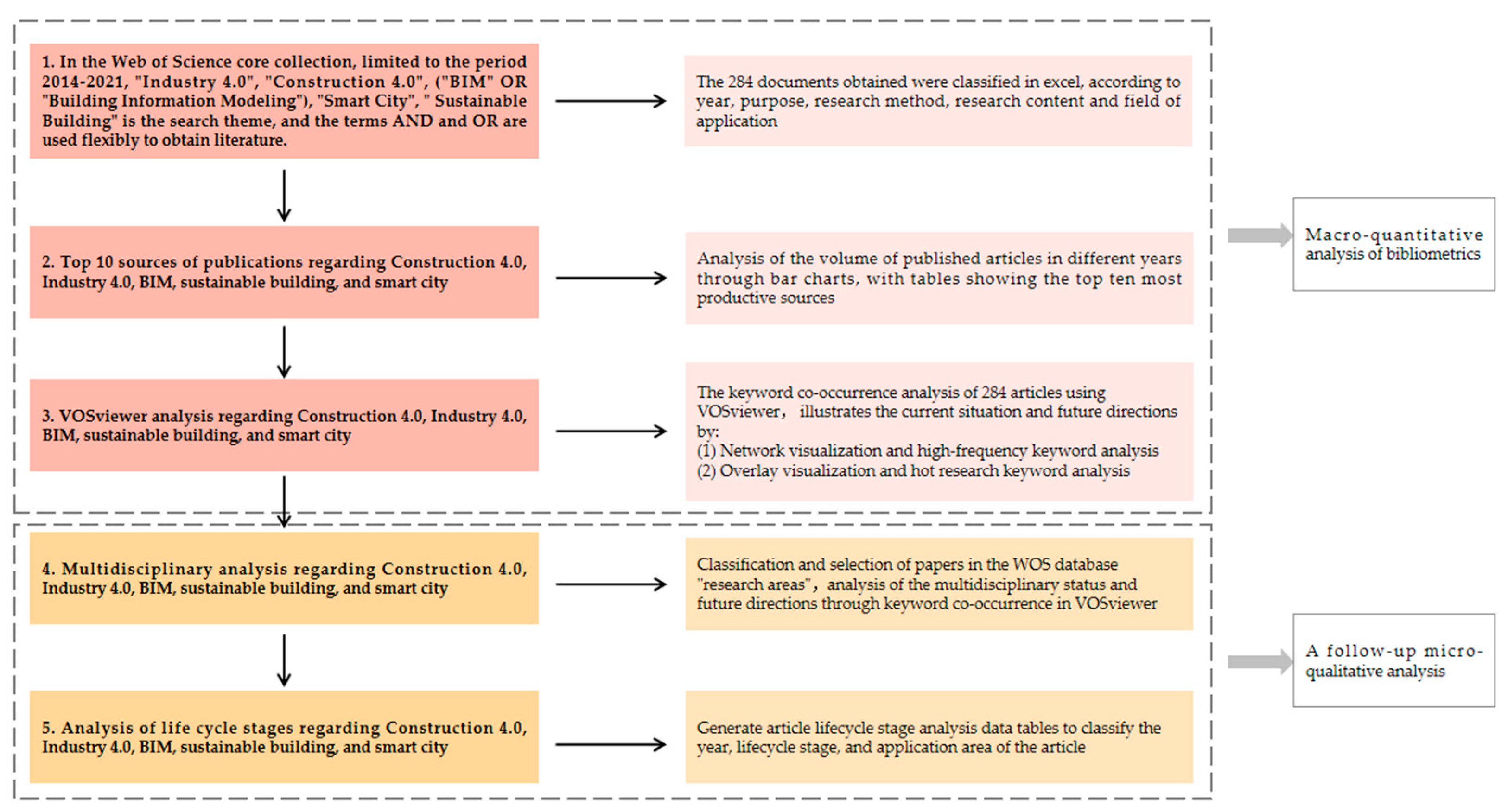
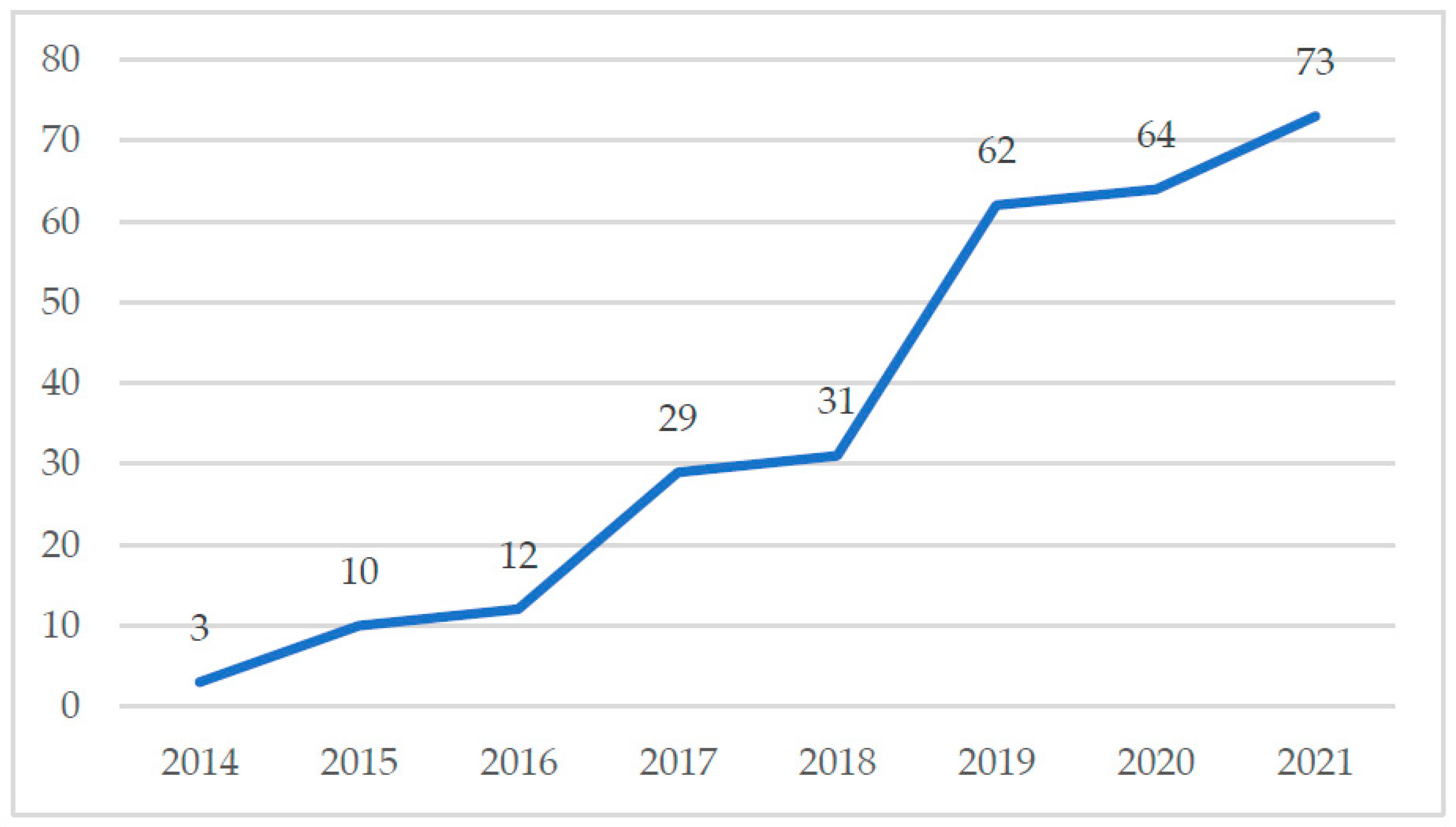
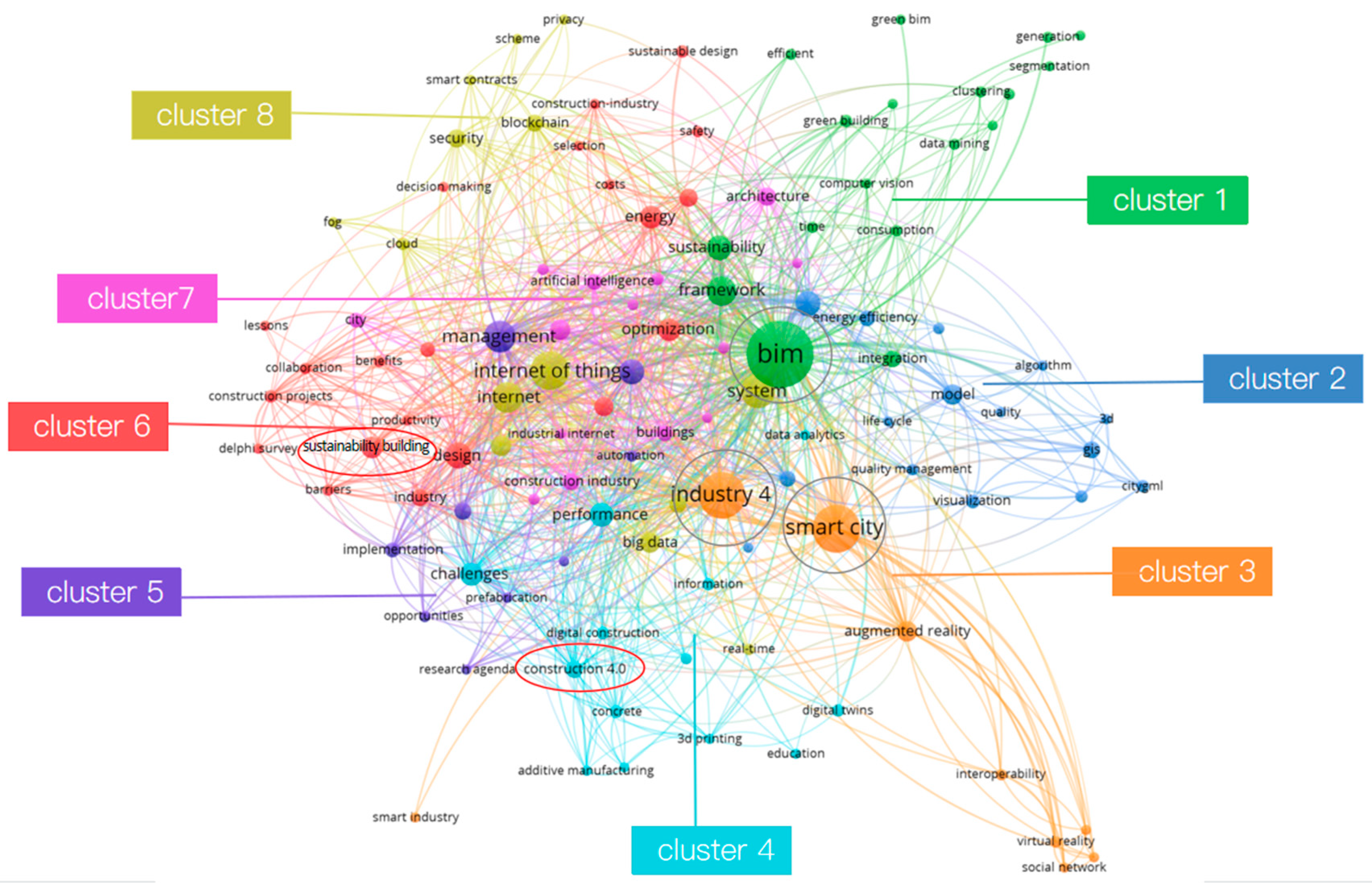
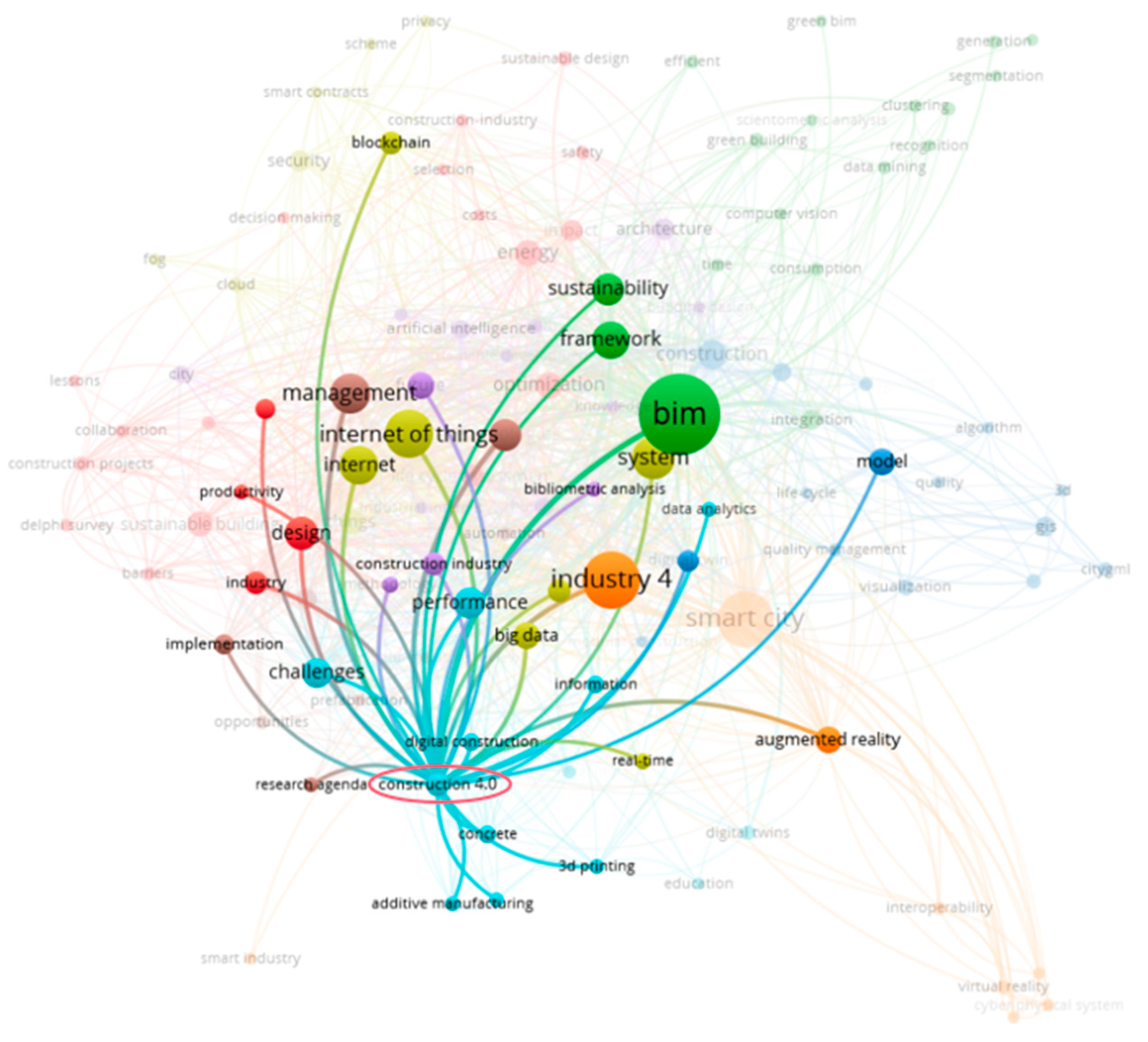
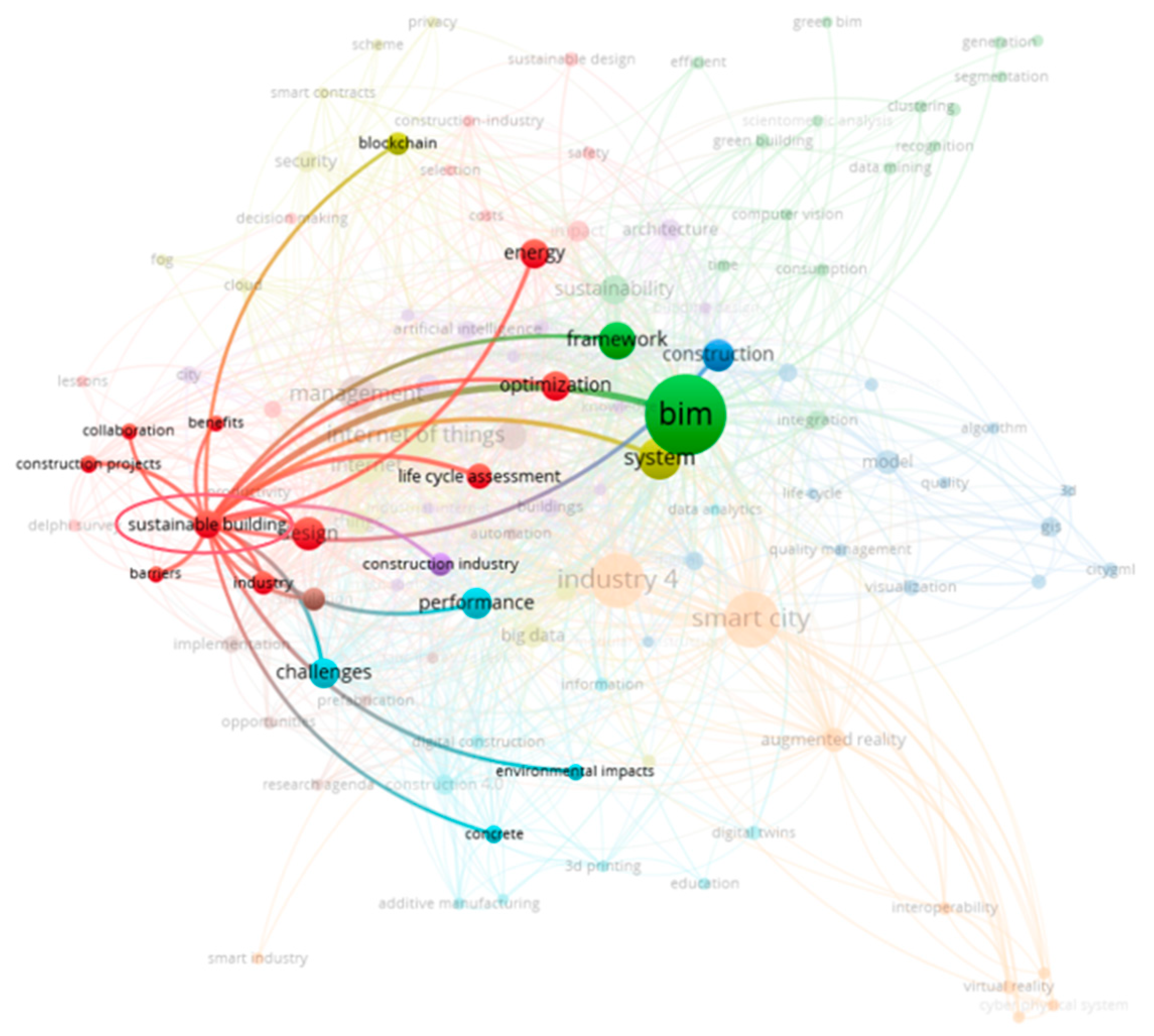


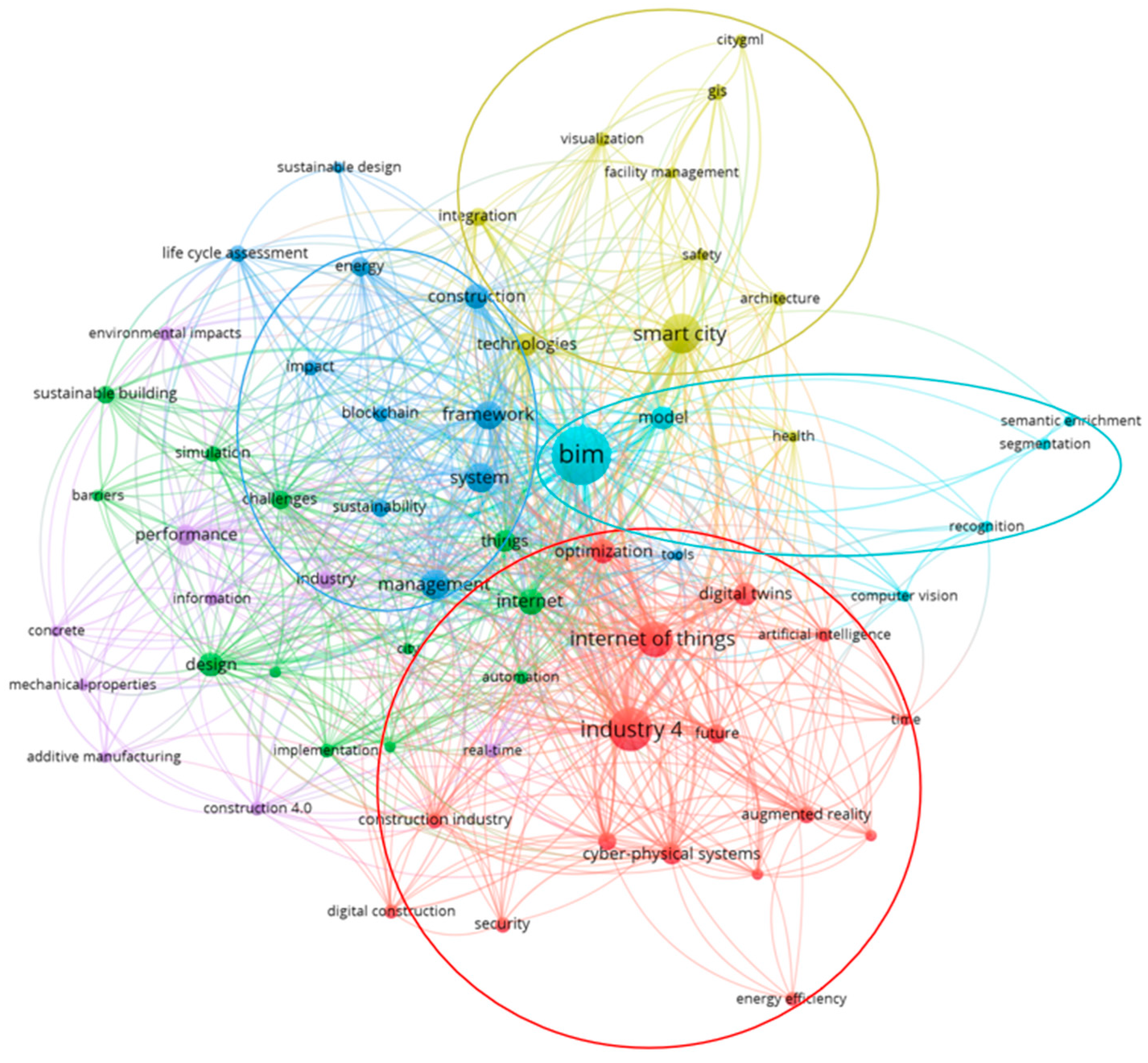
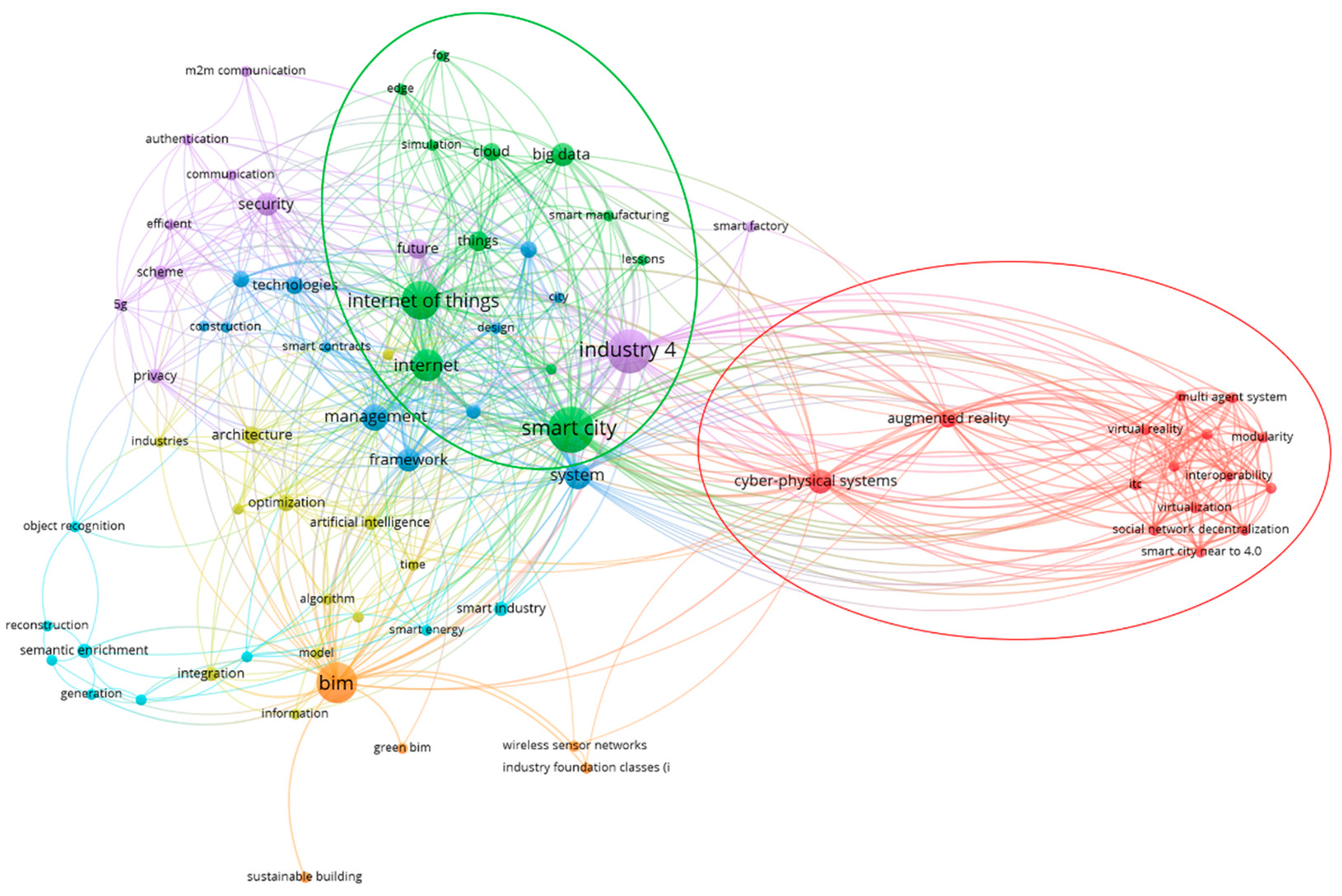

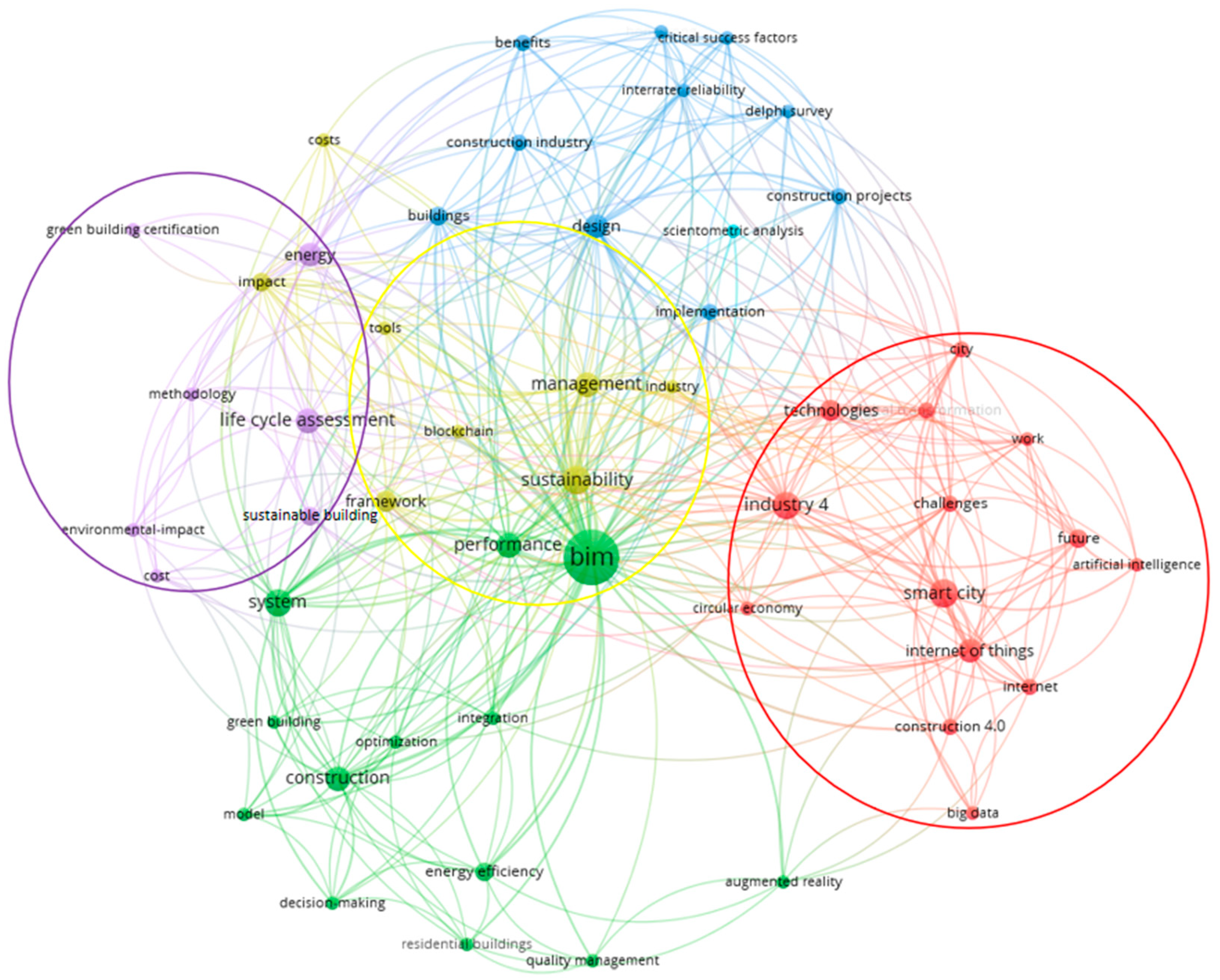
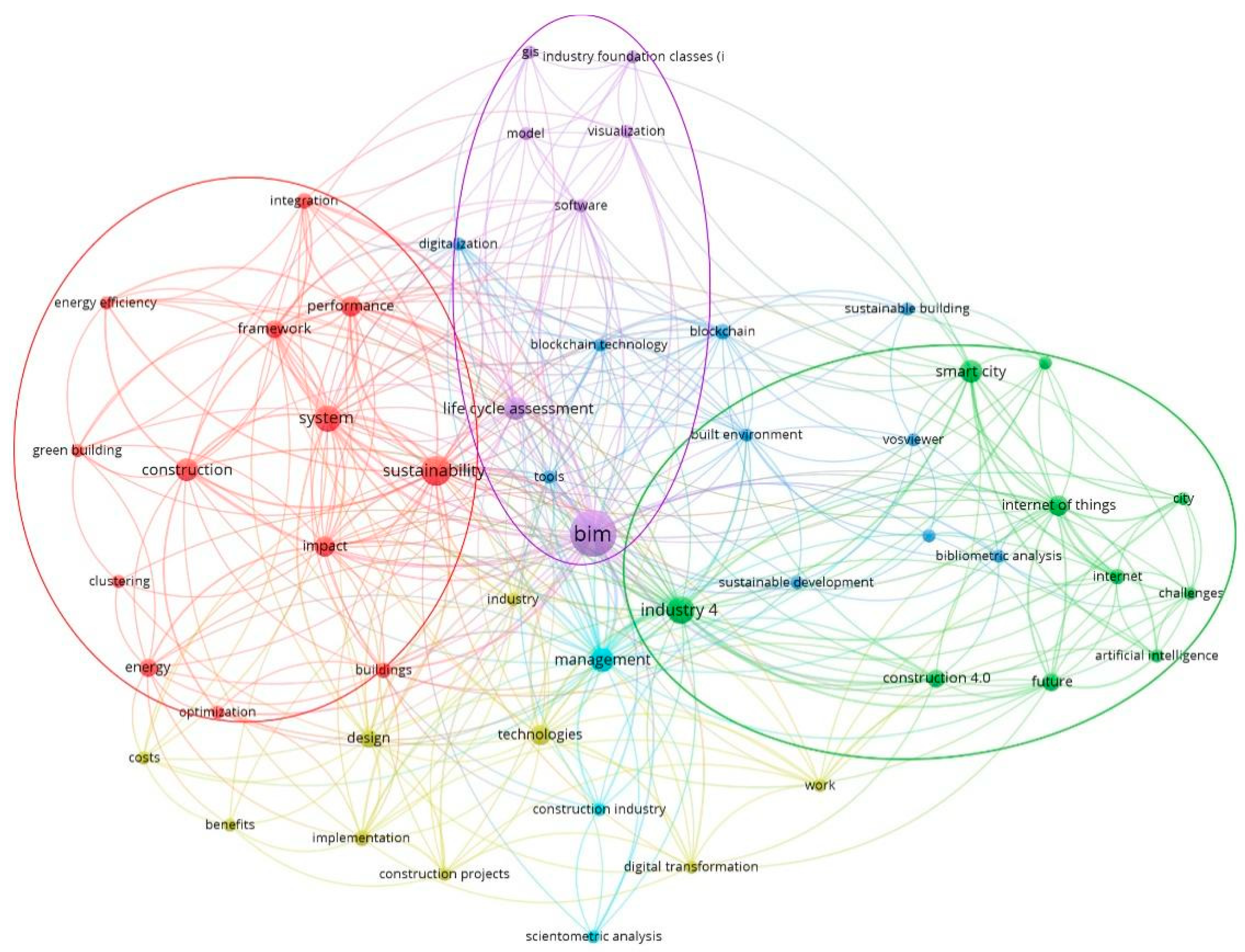


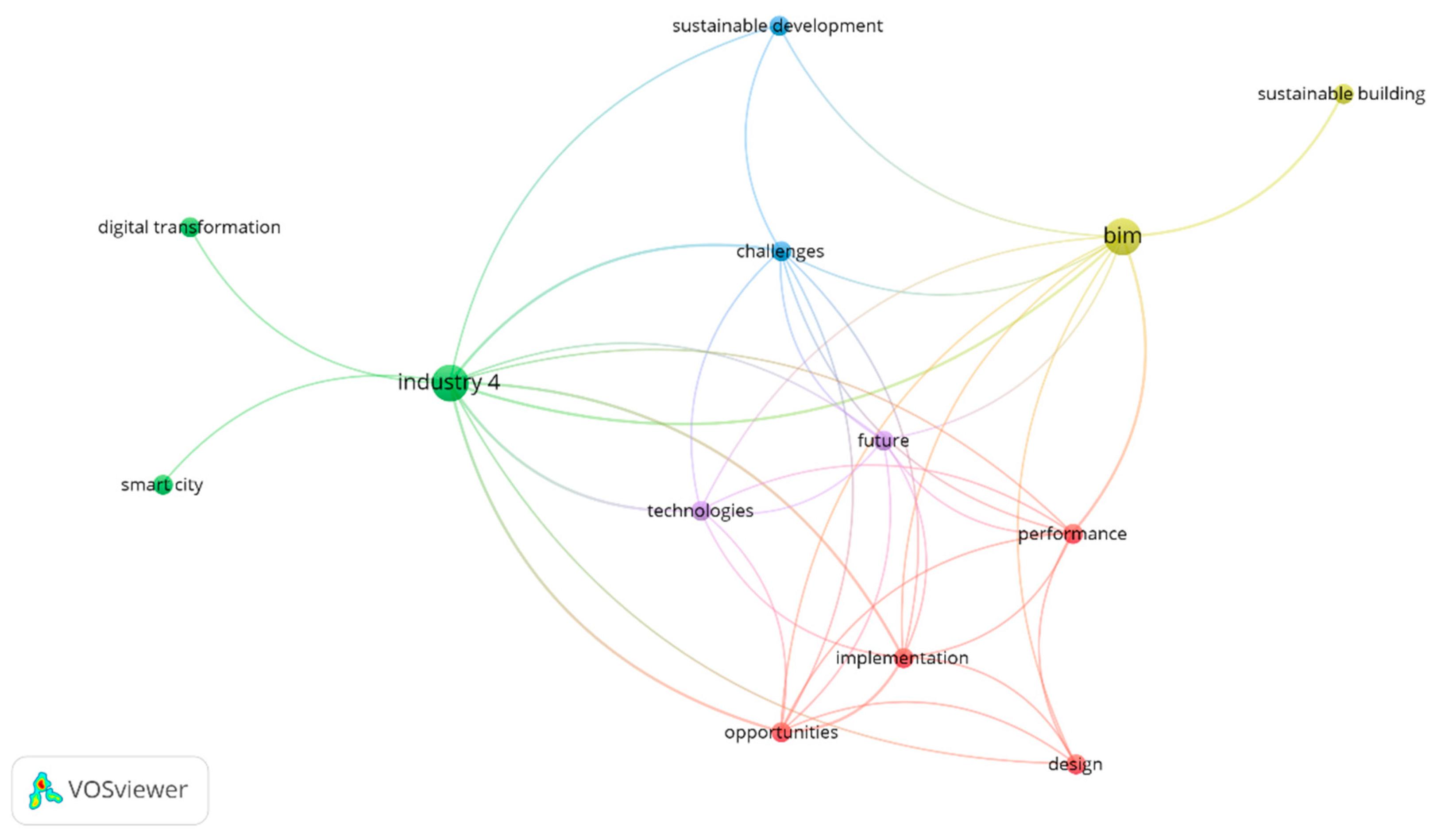

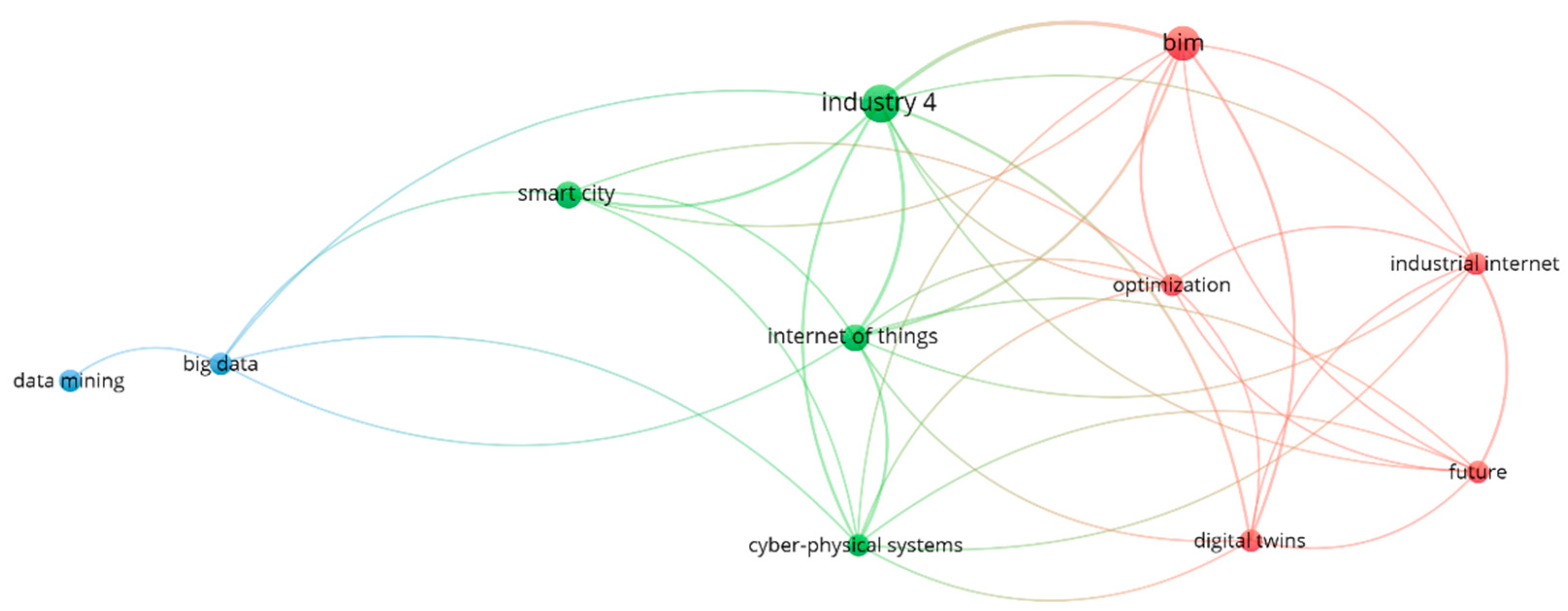
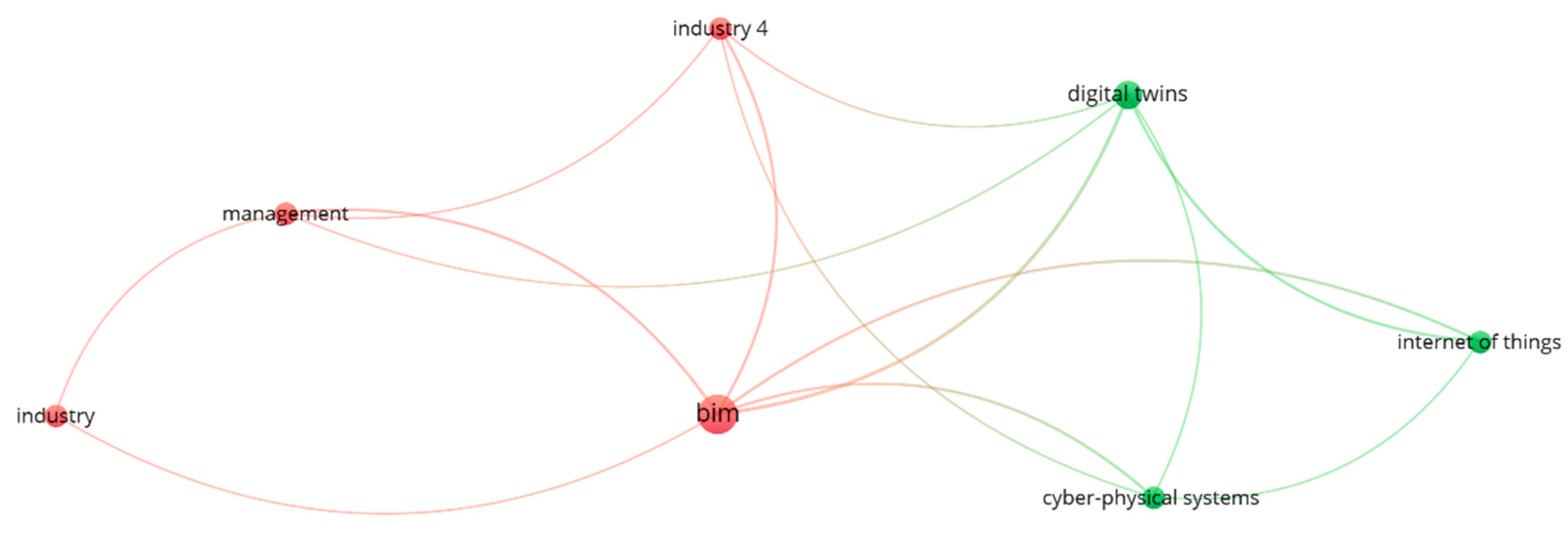
| Source | Web of Science Core Collection |
|---|---|
| Citation | SCI-EXPANDED, SSCI, CPCI-S, CPCI-SSH, CCR-EXPANDED, IC |
| Search steps | #1 = (TS = ((“BIM” or “Building Information Modeling”) and (“Industry 4.0 “ or “Construction 4.0 “) and (“Smart City” or “Sustainable Building”))) #2 = (TS = ((“Industry 4.0 “or “Construction 4.0 “) and (“Smart City” or “Sustainable Building”))) #3 = (TS = ((“Industry 4.0 “or “Construction 4.0 “) and (“BIM” or “Building Information Modeling”))) #4 = (TS = ((“Smart City” or “Sustainable Building”) and (“BIM” or “Building Information Modeling”))) #5 = #4 OR #3 OR #2 OR #1 |
| Timespan | Year 2014–2021 |
| Qualified Records | 284 |
| Source | Web of Science Core Collection |
| Ranking | Source Titles | Number of Publications |
|---|---|---|
| Top1 | Sustainability | 23 |
| Top2 | Automation in Construction | 13 |
| Top3 | Buildings | 11 |
| Top4 | IEEE Access | 7 |
| Top5 | Applied Sciences Basel | 6 |
| Top6 | IOP Conference Series Materials Science and Engineering | 6 |
| Top7 | Advanced Engineering Informatics | 5 |
| Top8 | Journal of Building Engineering | 5 |
| Top9 | Journal of Cleaner Production | 5 |
| Top10 | Sensors | 5 |
| Color 1 | Cluster | Keyword | Occurrences | Total Link Strength |
|---|---|---|---|---|
| 2 | BIM | 128 | 518 | |
| 7 | smart city | 65 | 244 | |
| 7 | Industry 4.0 | 64 | 289 | |
| 4 | Internet of Things | 43 | 229 | |
| 4 | system | 34 | 185 | |
| 8 | management | 30 | 184 | |
| 4 | internet | 27 | 166 | |
| 2 | framework | 25 | 164 | |
| 1 | design | 20 | 130 | |
| 3 | construction | 18 | 104 | |
| 2 | sustainability | 18 | 92 | |
| 8 | technologies | 18 | 116 | |
| 6 | performance | 17 | 110 | |
| 6 | challenges | 15 | 109 | |
| 1 | energy | 15 | 78 | |
| 1 | optimization | 15 | 94 |
| Year | Color 1 | Keyword |
|---|---|---|
| 2016 |  | CityGML, sustainable design, virtual reality, social network |
| 2017 | sustainable building, simulation, cyber-physical systems, decision-making, fog | |
| 2018 | construction, big data, augmented reality, construction industry, GIS, construction projects, green building, industry foundation classes, automation, consumption | |
| 2019 | BIM, smart city, Industry 4.0, Internet of Things, system, framework, design, sustainability, technologies, performance | |
| 2020 | management, internet, future, things, blockchain, Construction 4.0, artificial intelligence, city, implementation | |
| 2021 | DTs, productivity |
| Source | Year | Research Method | Topic |
|---|---|---|---|
| Ekasanti et al. | 2021 | Literature review | BIM as a tool for assessing the quality of sustainable design for low-income housing |
| Harter et al. | 2020 | Modeling and case study | Uncertainty analysis of the design in early LCA |
| Li et al. | 2020 | Modeling | BIM for a smart city, based on a “BP neural network model” |
| Montiel-Santiago et al. | 2020 | Case study | Lighting system improvements in hospitals |
| Tao et al. | 2020 | Modeling and case study | Sustainable and healthy building design and operation |
| Zanni et al. | 2019 | Literature review | Integrating whole life cycle costs into the BIM process |
| Ebertshauser et al. | 2019 | Modeling | Connecting LCA tools with BIM |
| Liu et al. | 2019 | Modeling | BIM and blockchain-based sustainable building design information management |
| Liu et al. | 2019 | Modeling | BIM-based water saving framework |
| Maskuriy et al. | 2019 | Literature review | Industry 4.0 for the construction industry |
| Mgbere et al. | 2018 | Case study | Methods and tools to illustrate the use of BIM |
| Ahmad et al. | 2017 | Modeling | Design-iterative BIM |
| Liu et al. | 2017 | Modeling | Building energy simulation |
| Marzouk et al. | 2016 | Modeling | Framework for sustainable low-income housing projects |
| Inyim et al. | 2015 | Modeling and case study | The BIM extension component, SimulEICon, helps with building design decisions |
| Choi et al. | 2015 | Literature review | Interface mapping approach for energy performance assessment |
| Liu | 2015 | Literature review | Optimizing building design solutions and saving costs |
| Jalaei et al. | 2015 | Modeling and case study | Green building certification system and BIM |
| Liu et al. | 2015 | Literature review | Building design optimization methodology |
| Wong et al. | 2014 | Modeling and case study | Sustainable building assessment |
| Source | Year | Research Method | Topic |
|---|---|---|---|
| Begic et al. | 2021 | Literature review | BIM 4.0 for Construction 4.0 |
| Turner et al. | 2021 | Literature review | Industry 4.0 on construction sites |
| Maskuriy et al. | 2019 | Literature review | Industry 4.0 for the construction industry |
| Liu et al. | 2019 | Modeling | Sustainable building design information management, based on BIM and blockchain |
| Liu et al. | 2019 | Modeling | BIM-based framework for water-saving |
| Mgbere et al. | 2018 | Case study | Methods and tools for BIM use |
| Wong et al. | 2014 | Modeling and case study | Sustainable building assessment |
| Source | Year | Research Method | Topic |
|---|---|---|---|
| Tao et al. | 2020 | Case study | Data infrastructure for sustainable health in building design and operational modeling |
| Montiel-Santiago et al. | 2020 | Case study | Lighting system improvements for hospitals |
| Chen et al. | 2019 | Modeling | Integration of building structure maintenance schedules and cost planning |
| GhaffarianHoseini et al. | 2017 | Literature review and modeling | Post-construction energy efficiency testing |
| Source | Year | Research Method | Topic |
|---|---|---|---|
| Xing et al. | 2020 | Modeling and case study | Reuse of building components |
| Widyatmoko et al. | 2020 | Literature review | Construction of roads with recycled materials |
| Starynina et al. | 2020 | Modeling | Modernization of public building |
| GhaffarianHoseini et al. | 2017 | Literature review and modeling | Post-construction energy efficiency testing |
| Liu et al. | 2014 | Modeling and case study | Energy-efficiency design retrofit of existing building facades |
| Source | Year | Research Method | Topic |
|---|---|---|---|
| Ozturk et al. | 2021 | Literature review | An overview of the AECO-FM industry’s DTs |
| Pai et al. | 2021 | Literature review and case study | LEED’s approach to WBLCA compliance |
| Yitmen et al. | 2021 | Modeling | A cognitive DTs model for building lifecycle management |
| Liu et al. | 2021 | Literature review | Integration of blockchain and BIM in smart city |
| Xue et al. | 2021 | Literature review | BIM integrated LCA and the circular economy |
| Liu et al. | 2021 | Literature review | Sustainable building management |
| Lorenzo et al. | 2020 | Modeling | Bamboo straw digitization for structural applications |
| Horn et al. | 2020 | Literature review | Integrating LCA into master planning |
| Veselka et al. | 2020 | Literature review | LCA integrated BIM in green building certification |
| Panteli et al. | 2020 | Literature review | Building integration models in the smart building sector |
| Pucko et al. | 2020 | Literature review | Integrated energy and whole life cycle cost analysis of building envelope components |
| Teply | 2020 | Literature review | EDSM method for additive technology to help with complete lifecycle management |
| Chelyshkov | 2019 | Modeling | Development and application of data exchange and management processes |
| Kuzina | 2019 | Modeling | Development of operational information models for smart city control systems |
| Brockmann | 2019 | Literature review | Open international data networks |
| Figl et al. | 2019 | Modeling | Life cycle analysis in building planning and construction, with a focus on carbon dioxide neutrality |
| Shrivastava et al. | 2019 | Literature review | Development of BIM tools for green and sustainable building design |
| Najjar et al. | 2019 | Modeling | Integration and optimization of energy-efficient building power generation |
| Ding et al. | 2018 | Modeling | Smart steel bridge construction |
| Seghier et al. | 2018 | Literature review | BIM and green building rating system integration |
| Najjar et al. | 2017 | Literature review and case study | BIM integrated with LCA |
| Shahrour et al. | 2017 | Literature review | Synthesis of minimal tools for city, infrastructure, and building modeling |
| Postranecky et al. | 2017 | Literature review | Industry 4.0 for theoretical models of smart city |
| Kylili et al. | 2017 | Literature review | Policies and trends in sustainability assessment of existing building materials in Europe |
| Chen et al. | 2017 | Literature review | BIM technology to enhance sustainable building goals and performance |
| Ginzburg | 2016 | Literature review | The use of unified information models (BIM models) throughout the building life cycle in the Russian Federation |
Publisher’s Note: MDPI stays neutral with regard to jurisdictional claims in published maps and institutional affiliations. |
© 2022 by the authors. Licensee MDPI, Basel, Switzerland. This article is an open access article distributed under the terms and conditions of the Creative Commons Attribution (CC BY) license (https://creativecommons.org/licenses/by/4.0/).
Share and Cite
Chen, Y.; Huang, D.; Liu, Z.; Osmani, M.; Demian, P. Construction 4.0, Industry 4.0, and Building Information Modeling (BIM) for Sustainable Building Development within the Smart City. Sustainability 2022, 14, 10028. https://doi.org/10.3390/su141610028
Chen Y, Huang D, Liu Z, Osmani M, Demian P. Construction 4.0, Industry 4.0, and Building Information Modeling (BIM) for Sustainable Building Development within the Smart City. Sustainability. 2022; 14(16):10028. https://doi.org/10.3390/su141610028
Chicago/Turabian StyleChen, Yali, Dan Huang, Zhen Liu, Mohamed Osmani, and Peter Demian. 2022. "Construction 4.0, Industry 4.0, and Building Information Modeling (BIM) for Sustainable Building Development within the Smart City" Sustainability 14, no. 16: 10028. https://doi.org/10.3390/su141610028
APA StyleChen, Y., Huang, D., Liu, Z., Osmani, M., & Demian, P. (2022). Construction 4.0, Industry 4.0, and Building Information Modeling (BIM) for Sustainable Building Development within the Smart City. Sustainability, 14(16), 10028. https://doi.org/10.3390/su141610028








